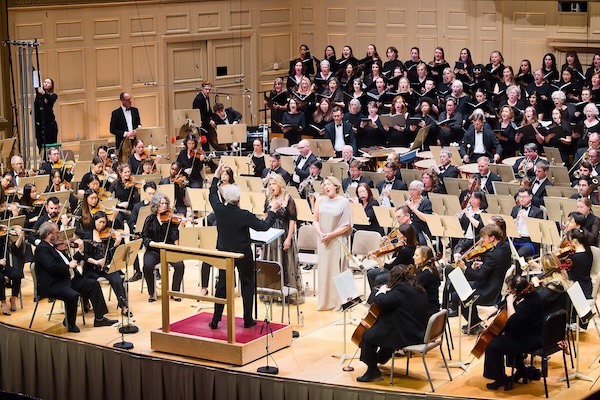Concert Review: Boston Philharmonic Orchestra Plays Mahler
By Jonathan Blumhofer
This was a Resurrection Symphony for today: urgent and unsettled, yes, but also searching, persevering, and, ultimately, triumphant. If the weekend turns out to have marked conductor Benjamin Zander’s last go-around with this masterpiece, what a way to finish.

The Boston Philharmonic performing Gustav Mahler’s Resurrection Symphony. Photo: Hilary Scott
Few works leave a bigger impression or make for a grander season finale than Gustav Mahler’s Resurrection Symphony. On Friday night at Symphony Hall, this epic meditation on life, death, and the world to come admirably fulfilled both of those purposes — and perhaps a few more —for Benjamin Zander and the Boston Philharmonic Orchestra.
The 86-year-old maestro is an old hand in this repertoire, having first conducted this Mahler symphony, his No. 2, with the BPO in 1982. Though they’ve revisited the work periodically since (most recently in 2017), a certain poignancy underlined the pairing’s latest traversal.
That Zander, as he moves through his ninth decade, remains at the top of his musical game is cause for celebration. At the same time, the conductor is the first to admit that he’s not getting any younger: in preperformance remarks, he noted that Friday’s concert might be his last time conducting this score. As if to emphasize the point, Marina Mahler, the composer’s granddaughter, was on hand to briefly introduce the work and thank Zander for his lifelong devotion to her illustrious forebear’s music.
Once conductor and orchestra got down to business, however, there was nothing unduly solemn or valedictory about what transpired. Instead, Friday’s was a Resurrection Symphony that underscored Zander’s and his orchestra’s long association with this music — as well as the Mahler tradition they together have done more than virtually anyone else to cultivate in Boston over the last 40-plus years.

Soprano Miah Persson, mezzo-soprano Dame Sarah Connolly, and conductor Benjamin Zander in a performance of Gustav Mahler’s Resurrection Symphony. Photo: Hilary Scott
From the downbeat of the big first movement, the ensemble’s playing was electrifying. Here, the music’s stark plays of volume, texture, and character were all precisely calibrated. Indeed, the BPO’s approach to the section’s many little details — its colors, articulations, and counterpoint, especially — were smartly unified. As a result, its whiplash changes of mood and temperament held together with uncommon focus.
Not many conductors take Mahler’s recommendation of a five-minute pause between the Second’s opening two movements literally. But the composer was on to something, as Zander, who observed nearly that long a break on Friday, proved; a ländler of uncommon freshness followed.
True, some of that aura owed to the conductor’s lively tempos. To be sure, his well-directed take on this Andante moderato (the indication means a moderate walking speed) was one of which Mahler — who was known for his vigorous physical exertions — might have approved.
Yet both here and in the ensuing Scherzo, nothing felt forced or rushed, thanks to the reading’s flexible approach to phrasings. Accordingly, these middle movements sang and danced with a becoming naturalness.
Much the same followed in the fourth movement’s “Ulricht” setting, which Dame Sarah Connolly delivered with exquisite warmth and introspection. Here, too, the BPO managed an accompaniment of touching discretion, highlighted by principal oboe Peggy Pearson’s limpid solos.
In the finale, Zander and Co. fluently navigated the score’s ups and downs. Just like the first movement, this essay moves in paragraphs that can sound (and feel) episodic. Yet, as earlier in the night, the conductor’s command of the music’s style and syntax ensured that no longueurs obtained.
Quite the opposite, really. The marches drove headlong. The movement’s song quotations were each shapely and intense. Its depictions of earthquakes, the Last Judgment, tombs flung open, and processions of redeemed souls — all these unfolded with surety of musical purpose and drama, not to mention palpable spiritual conviction.
Not even little blemishes — like the chorus’s a cappella entrance inadvertently sinking about half a tone before the orchestra joined them — detracted. Rather, this was a finale of heaven-storming accomplishment.
Soprano Miah Persson and Connolly wove a winsome tapestry in their duets. Jamie Kirsch’s Chorus pro Musica delivered their injunctions of texts by Mahler and Friedrich Klopstock, be they hushed or roaring, with warmly blended tone and good diction. The BPO, ever responsive, both cushioned the singers and forged the path before them. Colin Lynch’s delivery of the short organ part was the last word in resplendence.
The result was a Resurrection Symphony for today: urgent and unsettled, yes, but also searching, persevering, and, ultimately, triumphant. Friday’s sold-out house responded to it, aptly, with thunder. If the weekend turns out to have marked Zander’s last go-around with this masterpiece, what a way to finish. This was a Mahler performance of the rarest kind — one fully worthy of the music itself.
Jonathan Blumhofer is a composer and violist who has been active in the greater Boston area since 2004. His music has received numerous awards and been performed by various ensembles, including the American Composers Orchestra, Kiev Philharmonic, Camerata Chicago, Xanthos Ensemble, and Juventas New Music Group. Since receiving his doctorate from Boston University in 2010, Jon has taught at Clark University, Worcester Polytechnic Institute, and online for the University of Phoenix, in addition to writing music criticism for the Worcester Telegram & Gazette.
Tagged: Benjamin-Zander, Boston Philharmonic Orchestra, Dame Sarah Connolly
